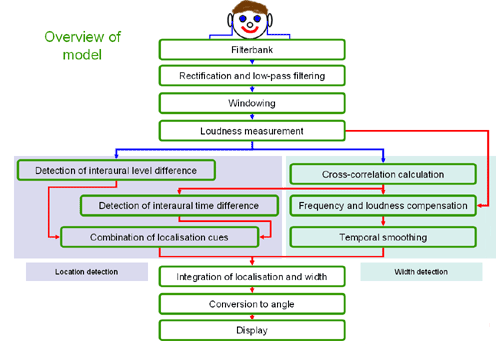Overview of the measurement model
The measurement model that we are in the process of developing is outlined
below in a simple block diagram. Clicking on any of the components of the model will show more information about that particular part.
Purpose
The purpose of the model is to measure the perceived width of a particular sound. Depending on the portion of the sound selected, this could either be the perceived source width or the perceived environment width. In the future, the model may be able to automatically separate these two components, though this may take some time to achieve successfully.
Applicability
The measurement is designed to be as widely applicable as possible in that it should be able to accurately predict the perceived source or environment width of any binaural signal that is fed into it. This means that it should work for any situation where a human listener can perceive the source or environment width of a sound, be it concert hall acoustics, reproduced sound, virtual reality, or any other form of listening.
Background
The central calculation on which the measurement model is based is the interaural cross-correlation coefficient (IACC). This was shown to be inversely related to the perceived width of auditory stimuli as early as the 1960s [
Chernyak and Dubrovsky 1968,
Keet 1968]. Measurement models based on this calculation have been developed by a number of researchers, however it is apparent that there are still problems with the implementation, in that results are not directly comparable for a wide range of situations. The model described here is being developed to solve a number of these problems. More information about this can be found in the detailed descriptions of the model segments labelled on the diagram below and listed on the menu to the left.

- where
 indicates an audio signal and
indicates an audio signal and  indicates a data signal.
indicates a data signal.

 indicates an audio signal and
indicates an audio signal and  indicates a data signal.
indicates a data signal.